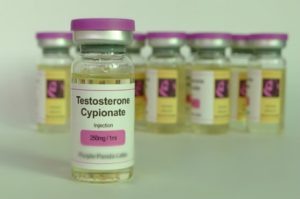10 Social Media’s Effect on Anabolic Steroid Abuse in Adolescents
Samuel Hurley
Introduction
With the rise of social media, more people report dissatisfaction with their bodies. This is a significant driver of a hidden epidemic: anabolic steroid abuse (Goldman et al., 2020). The full extent of this problem is unknown, as many people do not disclose to their doctor if they are using anabolic steroids. Non-professional athletes comprise 80% of anabolic steroid users and are never tested (Goldman et al., 2018). Trends suggest that anabolic steroid use is increasing, yet large-scale data collection for steroid use is not occurring (Ganesan et al., 2022). This chapter will discuss the rise of anabolic steroids and other similar anabolic drugs in the context of the recent social media explosion of the 2010s and 2020s.
What Are Anabolic Steroids?

Anabolic steroids are performance enhancing and image-enhancing drugs that can cause a person to build muscle and lose fat. Steroids are substances derived from cholesterol, a type of fat found within the body. The fatty structure of steroids allows them to enter directly into cells so that they can affect cells from inside. Anabolic means “to build up,” which is precisely what anabolic steroids do to the body. Upon entering the cell, anabolic steroids bind to DNA and cause the cells to produce more proteins than average (Ganesan, 2022). This results in increased muscle mass and decreased fat in users. An example of this is renowned bodybuilder and actor, Arnold Schwarzenegger, pictured to the right.
While many different anabolic steroids exist, most are made in a lab to mimic testosterone (Mayo Clinic, 2022). Testosterone is the hormone responsible for sperm production, increasing sex drive, developing muscle mass, strengthening bone density, and secondary sex characteristics (Harvard Medical School, 2019). The most commonly used anabolic steroids include testosterone, trenbolone, and drostanolone. Street names for anabolic steroids include juice, gear, gym candy, Arnolds, roids, pumpers, and stackers (United States Drug Enforcement Administration, 2020). To mitigate side effects and avoid building a tolerance, users often cycle anabolic steroids on and off in 6-18 week timeframes. Multiple of these different anabolic steroids are often combined and used at the same time, called stacking (de Ronde & Smit, 2020). Anabolic steroids are most commonly taken by injection into the muscle, orally with pills, or as topical creams or gels (National Health Service, 2022).
Although gaining muscle and losing fat may seem healthy, anabolic steroids have many negative health effects. These include infertility, shrunken testicles, sexual dysfunction, cardiomyopathy, and depression (Goldman et al., 2019). Especially with long-term use, anabolic steroids can severely harm one’s health.
The Rise of Social Media
Social media is any means by which people can create, share content or information, and network. With the technological advancements of the recent past, such as the inventions of modern computers, smartphones, and the internet, the virtual space and the number of potential social media users have vastly increased (Shah, 2016). The first social media platform was born in 1997, but social media began to become much more popular with the release of MySpace in 2003 (Shah, 2016). The popularity of these platforms among adolescents has steadily risen since 2010 and constantly changes with the release of new platforms such as TikTok (Vogels et al., 2022). As of 2022, adolescents’ most popular social media platforms are Youtube, TikTok, Instagram, and Snapchat, which heavily revolve around videos and images (Vogels et al., 2022).
In recent years, teenagers have faced constant exposure to social media, including fitness media, where many content creators have large, lean muscles. Whether the creator is on anabolic steroids, takes the pictures at the best angles, or edits their pictures, this content leads adolescents to compare themselves to these content creators with the ideal physique. These social media comparisons can result in body dissatisfaction and dysmorphia, and according to a recent study, as many as 69% of male adolescents suffer from body dissatisfaction or body dysmorphia (Quittkat et al., 2019). This body dissatisfaction is associated with the increasing use of anabolic steroids in adolescents (Hilkens et al., 2021). Because these adolescents perceive something wrong with their appearance, they are at a higher risk for using anabolic steroids to change those perceptions. (Goncalves et al., 2022). Additionally, despite good intentions, recent social media movements such as fitspo contribute greatly to this body dissatisfaction and issues with mental health (Raggatt et al., 2018).
Policy and Problems

The United States federal government lists anabolic steroids as Schedule III drugs. A Schedule III drug is approved for some medical use and has a moderate to low risk for psychological or physical dependence (United States Drug Enforcement Administration, 2018). Testosterone is often prescribed for testosterone therapy (TT) in people with low testosterone levels. Low testosterone applies especially to older men, whose levels fall as they age (Nackeeran et al., 2022). Pictured to the right are vials of testosterone which would be used for testosterone therapy.
Conclusion
Because anabolic steroids are illegal if not prescribed, there is no regulation and minimal research. Limited resources are available for anabolic steroid abusers, making this problem worse. Public implementation of harm reduction is necessary to fix these issues. Harm reduction could be as simple as distributing clean needles or monitoring the health of abusers who do not plan to stop. (Bonnecaze et al., 2021). Research, regulation, and better treatment are essential to tackling the hidden epidemic of anabolic steroids. However, improvement in these areas will only be considered if there is more public awareness. If health outcomes are to improve, it is time that this hidden epidemic be exposed.
Review Questions
1. Which of the following is NOT one of the most common types of anabolic steroids?
a. Testanolone
b. Trenbolone
c. Testosterone
d. Drostanolone
2. Which of the following has contributed most to the rising body dysmorphia in adolescents?
a. Image-based social media
b. Testosterone therapy
c. The desire to be a professional athlete
d. Harm reduction strategies
3. Which of these is a good example of harm reduction for anabolic steroid users?
a. Arresting people who are caught with non-prescribed anabolic steroids
b. Offering free, clean needles to anabolic steroid users
c. Decreasing jail time for anabolic steroid users
d. Having an intervention with the anabolic steroid users to make them stop their behavior
References
Bonnecaze, A.K., O’Connor, T. & Burns, C.A. (2021). Harm reduction in male patients actively using anabolic androgenic steroids (AAS) and performance-enhancing drugs (PEDs): a review. Journal of General Internal Medicine, 36, 2055–2064. https://doi.org/10.1007/s11606-021-06751-3
de Ronde, W., & Smit, D. L. (2020). Anabolic androgenic steroid abuse in young males. Endocrine Connections, 9(4), R102-R111. https://ec.bioscientifica.com/view/journals/ec/9/4/EC-19-0557.xml
Ganesan K., Rahman S., Zito P. M. (2022). Anabolic steroids. StatPearls Publishing. https://www.ncbi.nlm.nih.gov/books/NBK482418/
Goldman, A.L., Pope, H.G., Jr., & Bhasin, S. (2019). The health threat posed by the hidden epidemic of anabolic steroid use and body image disorders among young men. The Journal of Clinical Endocrinology & Metabolism, 104(4), 1069–1074. https://doi.org/10.1210/jc.2018-01706
Gonçalves, L., Zanlorenci, S., Borges, L. L., de Lima, T. R., & Silva, D. A. S. (2022). Body weight dissatisfaction and health risk behaviors in adolescents. Perceptual and Motor Skills. https://doi.org/10.1177/00315125221137678
Harvard Medical School. (2019, August 29). Testosterone — what it does and doesn’t do. Harvard Health Publishing. https://www.health.harvard.edu/medications/testosterone–what-it-does-and-doesnt-do
Hahamyan H. A., Vasireddi N., Voos J. E., & Calcei J. G. (2022). Social media’s impact on widespread SARMs abuse. The Physician and Sportsmedicine. https://doi.org/10.1080/00913847.2022.2078679
Hildebrandt, T., Alfano, L., & Langenbucher, J. W. (2010). Body image disturbance in 1000 male appearance and performance enhancing drug users. Journal of Psychiatric Research, 44(13), 841-846. https://doi.org/10.1016/j.jpsychires.2010.01.001
Hilkens, L., Cruyff, M., Woertman, L., Benjamins, J., & Evers, C. (2021). Social media, body image and resistance training: Creating the perfect ‘Me’ with dietary supplements, anabolic steroids and SARM’s. Sports Medicine – Open 7, 81. https://doi.org/10.1186/s40798-021-00371-1
Mayo Clinic. (2022, December 10). Performance-enhancing drugs: know the risk. https://www.mayoclinic.org/healthy-lifestyle/fitness/in-depth/performance-enhancing-drugs/art-20046134
Nackeeran, S., Patel, M. S., Nallakumar, D. T., Ory, J., Kohn, T., Deibert, C. M., Carto, C., & Ranjith, R. (2022). Testosterone Therapy is associated with depression, suicidality, and intentional self-harm: analysis of a national federated database. The Journal of Sexual Medicine 19(6), 933-939. https://doi.org/10.1016/j.jsxm.2022.03.611.
National Health Service. (2022, April 13). Anabolic steroid misuse. https://www.nhs.uk/conditions/anabolic-steroid-misuse/#:~:text=Anabolic%20steroids%20are%20usually%20injected,they%20can%20avoid%20side%20effects.
Quittkat H. L., Hartmann A. S, Düsing R., Buhlmann U., & Vocks S. (2019). Body dissatisfaction, importance of appearance, and body appreciation in men and women over the lifespan. Frontiers in Psychiatry, 10, 864. https://doi.org/10.3389/fpsyt.2019.00864
Raggatt M., Wright C. J. C., Carrotte E., Jenkinson R., Mulgrew K., Prichard I., & Lim M. S. C. (2018). “I aspire to look and feel healthy like the posts convey”: Engagement with fitness inspiration on social media and perceptions of its influence on health and wellbeing. BMC Public Health, 18, 1002. https://doi.org/10.1186/s12889-018-5930-7
Richardson, A., Dixon, K., & Kean, J. (2019). Superheroes – image and performance enhancing drug (IPED) use within the UK, social media and gym culture. Journal of Forensic and Legal Medicine, 64, 28-30. https://doi.org/10.1016/j.jflm.2019.03.009
Shah, S. (2016, May 14). The history of social networking. Digitaltrends. https://www.digitaltrends.com/computing/the-history-of-social-networking/
United States Drug Enforcement Administration. (2018, July 10). Drug scheduling. https://www.dea.gov/drug-information/drug-scheduling#:~:text=Schedule%20III%20drugs%2C%20substances%2C%20or,but%20more%20than%20Schedule%20IV.
United States Drug Enforcement Administration. (2020, April). Steroids. https://www.dea.gov/factsheets/steroids
Vogels, E. A., Gelles-Watnick, R., & Massarat, N. (2022, August 10). Teens, social media and technology 2022. Pew Research Center. https://www.pewresearch.org/internet/2022/08/10/teens-social-media-and-technology-2022/
higher than average levels of occurrence within a community
manmade versions of testosterone used in medicine to repair body tissues, increase appetite, and promote muscle growth
promoting the building of complex substances from simpler ones
improving one's performance by increasing one's strength and endurance
improving one's image by increasing one's size and muscle definition
the material within cells that contains the genetic information needed for the development and function of an organism
the body's chemical messengers
include facial and body hair, a deepened voice, and additional muscle mass
a person's diminished response to a drug over repeated exposure, requiring higher doses to feel the effect
the use of a combination of different anabolic steroids at the same time
inability to produce children
heart disease involving blockages of the heart or swelling of the heart muscle
individuals ages 10 to 19
large muscles and lean body for men
also referred to as body dysmorphic disorder, it is a mental health condition in which someone experiences extreme worry and negative thoughts about how their body looks
short for "fitness inspiration", a social media movement encouraging people to be active and fit
a hormone therapy in which a physician administers testosterone supplements at low levels
decreasing the danger of using a substance

